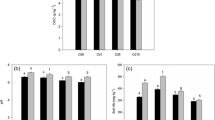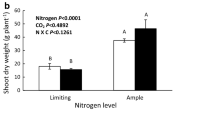Abstract
Previous reports have indicated positive effects of enriched rhizosphere dissolved inorganic carbon on the growth of salinity-stressed tomato (Lycopersicon esculentum L. Mill. cv. F144) plants. In the present work we tested whether a supply of CO2 enriched air to the roots of hydroponically grown tomato plants had an effect on nitrogen uptake in these plants. Uptake was followed over periods of 6 to 12 hours and measured as the depletion of nitrogen from the nutrient solution aerated with either ambient or CO2 enriched air. Enriched rhizosphere CO2 treatments (5000 μmol mol-1) increased NO3 - uptake up to 30% at pH 5.8 in hydroponically grown tomato plants compared to control treatments aerated with ambient CO2 (360 μmol mol-1). Enriched rhizosphere CO2 treatments had no effect on NH3 + uptake. Acetazolamide, an inhibitor of apoplastic carbonic anhydrase, increased NO3 - uptake in ambient rhizosphere CO2 treatments, but had no effect on NO3 - uptake in enriched rhizosphere CO2 treatments. Ethoxyzolamide, an inhibitor of both cytoplasmic and extracellular carbonic anhydrase, decreased NO3 - uptake in ambient rhizosphere CO2 treatments. In contrast, a CO2 enriched rhizosphere increased NO3 - uptake with ethoxyzolamide, although not to the same extent as in plants without ethoxyzolamide. It is suggested that a supply of enriched CO2 to the rhizosphere influenced NO3 - uptake through the formation of increased amounts of HCO3 - in the cytosol.
Similar content being viewed by others
References
Arnozis P A, Nelemans J A, Findenegg G R 1988 Phosphoenolpyruvate Carboxylase activity in plants grown with either NO +3 or NH +4 as inorganic nitrogen source. J. Plant Physiol. 132, 23–27.
Arteca R N, Poovaiah B W, Smith O E 1979 Changes in carbon fixation, tuberization and growth induced by CO2 application induced to the root zones of potato plants. Science 205, 1279–1280.
Barneix A J, Breteler H, Van de Geijn S C. 1984 Gas and ion exchanges in wheat roots after nitrogen supply. Physiol. Plant 61, 357–362.
Ben Zioni A, Vadia Y, Lips S H 1971 Nitrate uptake by roots as regulated by nitrate reduction products of the shoot. Physiol. Plant 24, 288–290.
Bialczyk J, Lechowski Z 1992 Absorption of HCO +3 by roots and its effect on carbon metabolism of tomato. J. Plant Nutr. 15, 293–312.
Cataldo D A, Haroon M, Schrader L E, Youngs V L 1975 Rapid colorimetric determination of nitrate in plant tissue by nitration of salicylic acid. Commun. Soil Sci. Plant Anal. 6, 7 1–80.
Clarkson D T 1986 In Fundamental, ecological and agricultural aspects of nitrogen metabolism in higher plants. Eds H Lamber et al, pp 3–27. Martinus Nijhoff Publishers, Dordrecht.
Cramer M D, Lewis O A M 1993 The influence of NO +3 and NH +4 nutrition on the carbon and nitrogen partitioning characteristics of wheat (Triticum aestivum L.) and maize (Zea mays L.) plants. Plant Soil 154, 289–300.
Cramer M D, Lewis O A M, Lips SH 1993 Inorganic carbon fixation and metabolism in maize roots as affected by nitrate and ammonium nutrition. Physiol. Plant 89, 632–639.
Cramer M D, Lips S H 1995 Enriched rhizosphere CO2 concentrations can ameliorate the influence of salinity on hydroponically grown tomato plants. Physiol. Plant 94, 425–432.
Cramer MD, Savidov N A, Lips S H 1996 The influence of enriched rhizosphere CO2 on N uptake and metabolism in wild-type and NR-deficient barley plants. Physiol. Plant 97, 47–54.
De Jong E, Schappert H J V 1972 Calculation of soil respiration and activity from CO2 profile in the soil. Soil Sci. 113, 328–333.
Doddema H, Telkamp G P 1979 Uptake of nitrate by mutants of Arabidopsis thaliana, disturbed in uptake or reduction of nitrate. Physiol. Plant 45, 332–338.
Enoch H Z, Olesen J M 1993 Plant response to irrigation with water enriched with carbon dioxide. New Phytol. 125, 249–258.
Gao Z F, Lips S H 1997 Effects of increasing inorganic carbon supply to roots on net nitrate uptake and assimilation in tomato seedlings. Physiol. Plant 101, 206–212.
Glass A DM, Siddiqi MY 1995 Nitrogen absorption by plant roots. In Nitrogen nutrition in higher plants. Eds H S Srivastava, R P Singh. pp 21–56. Associated Publishing Co., New Delhi.
Goltrerman H L, Clymo R 5 1969 Methods for chemical analysis of fresh waters – IBP Handbook No. 8, International Biological Programme. Blackwell Scientific Publications, Oxford.
Hewitt E J 1966 Sand and water culture methods used in the study of plant nutrition. In Technical communication no. 22. pp 431–432.Commonwealth Agricultural Bureau, Famham Royal.
Kaiser W M, Brendle-Behnish E 1995 Acid-base modulation of nitrate reductase in leaf tissues. Planta 196, 1–6.
King B J, Siddiqi M Y, Ruth T J, Warner R l, Glass A D M 1993 Feedback regulation of nitrate influx in Barley roots by nitrate, nitrite and ammonium. Plant Physiol. 102, 1279–1286.
Kurdjian A, Guern J 1989 Intracellular pH: measurement and importance in cell activity. Annu. Rev. Plant Physiol Plant Mol Biol 40, 271–303.
McClure P R, Kochian L V, Spanswick R M, Shaff J E 1990a Evidence for cotransport of nitrate and protons in Maize roots. I. Effects of nitrate on the membrane potential. Plant Physiol. 93, 281–289.
McClure P R, Kochian L V, Spanswick R M, Shaff J E 1990b Evidence for cotransport of nitrate and protons in Maize roots. II. Measurement of NO +3 ; and H+ fluxes with ion-selective microelectrodes. Plant Physiol. 93, 290–294.
Mercado J M, Niell F X, Figueroa F L 1997 Regulation of the mechanism for HCO +3 ; use by the inorganic carbon level in Porphyra leucosticta Thur. in Le Jolis (Rhodophyta). Planta 201, 319–325.
Norstadt F A, Porter L K 1984 Soil gases and temperatures: a beef cattle feedlot compared to alfalfa. Soil Sci. Soc. Am. J. 48, 783–789.
Schweizer P, Erismann K H 1985 Effect of nitrate and ammonium nutrition of non-nodulated Phaseolus vulgaris L. on phosphoenolpyruvate carboxylase and pyruvate kinase activity. Physiol. Plant. 78, 455–458.
Siddiqi M Y, Glass A D M, Ruth T J 1991 Studies of the uptake of nitrate in barley III. Compartmentation of NO +3 . J. Exp. Bot. 42, 1455–1463.
Siddiqi M Y, Glass A D M, Ruth T J, Rufty TW Jr. 1990 Studies of the uptake of nitrate in barley. Plant Physiol. 93, 1426–1432.
Snell F D, Snell C T 1949 Colorimetric methods of analysis. Van Norstrand, New York, NY.
Solorzano L 1969 Determination of ammonium in natural waters by the phenol hypochlorite method. Limnol. Oceanogr. 14, 799–801.
Thibaud J B, Grignon C 1981 Mechanism of nitrate uptake in corn roots. Plant Sci. Lett. 22, 279–289.
Toulon V, Sentenac H, Thibaud J-B, Soler A, Clarkson D, Grignon C 1989 Effect of HCO +3 concentration in the absorption solution on the energetic coupling of H+ – cotransports in roots of Zea mays L. Planta 179, 235–241.
Touraine B, Clarkson D T, Muller B 1994 Regulation of nitrate uptake at whole plant level, In A whole plant perspective on carbon-nitrogen interactions. Eds J Roy and Garnier. pp 11–30. SPB Academic Publishing, The Hague.
Van der Westhuizen M M, Cramer M D 1998 The influence of elevated rhizosphere dissolved inorganic carbon concentrations on respiratory O2 and CO2 flux in tomato roots. J. Exp. Bot. 49, 1977–1985.
Vapaavuori E M, Pelkonen P 1985 HCO +3 uptake through the roots and its effect on the productivity of willow cuttings. Plant Cell Environ. 8, 531–534.
Vuorinen A H, Rossi P. Vapaavuori E M 1995 Combined effect of inorganic carbon and different nitrogen sources in the growth media on biomass production and nitrogen uptake in young Willow and Birch plants. J. Plant Physiol. 147, 236–242.
Vuorinen A H, Vapaavuori E M, Lapinjoki S 1989 Time-course of uptake of dissolved inorganic carbon through willow roots in light and darkness. Physiol. Plant. 77, 33–38.
Vuorinen A H, Vapaavuori E M, Raaitikainen O, Lapinjoki S 1992 Metabolism of inorganic carbon taken up by roots in Salix plants. J. Exp. Bot. 43, 789–795.
Rights and permissions
About this article
Cite this article
van der Merwe, C., Cramer, M. Effect of enriched rhizosphere carbon dioxide on nitrate and ammonium uptake in hydroponically grown tomato plants. Plant and Soil 221, 5–11 (2000). https://doi.org/10.1023/A:1004751217650
Issue Date:
DOI: https://doi.org/10.1023/A:1004751217650




